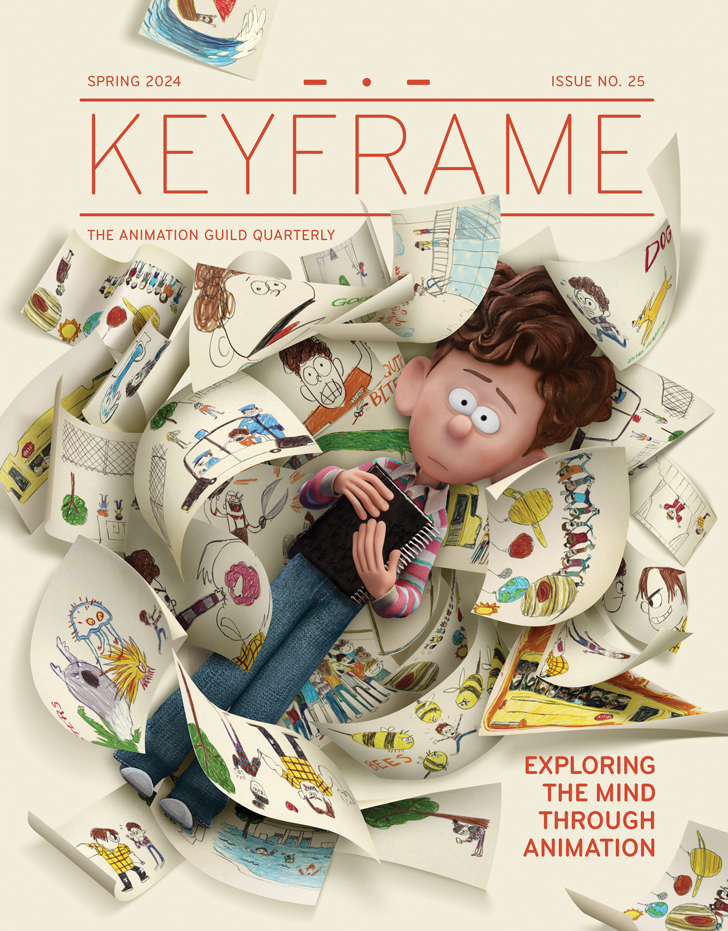For the last 15 years, DreamWorks Animation has been known for its cutting-edge CG animated films, so it may seem unexpected that its first employee-directed short is done entirely in 2D animation. Certainly, the director—supervising animator Salazar—didn’t anticipate his concept would be chosen during a short film pitch session held by the company last June.
“I was very surprised because it’s a 2D movie in a very high-tech CG studio,” says Salazar, whose short titled, Bird Karma, debuts this month at the New York International Children’s Film Festival.
The story follows a bird that is completely content in its life eating gray fish. Then one day a glorious red fish appears and from that day forward, the bird is obsessed with catching the elusive creature.
“The theme behind the story is to be happy with what you have or be careful for what you wish for …”—William Salazar
“The theme behind the story is to be happy with what you have or be careful for what you wish for,” says Salazar. “What you wish sometimes is not good for you [and] your actions have consequences.”
The animator started his journey with this particular story 23 years ago, inspired by a piece of Indian tribal music. He animated about a minute and a half of the story then shelved the project when he started working professionally. For the last two decades, he’s worked at DreamWorks on both 2D (The Prince of Egypt, Sinbad) and CG (Shark Tale, Kung Fu Panda) projects but he never forgot his short film idea.
“My dream had always been to do it at DreamWorks,” he says, so when the company invited employees to pitch short film ideas last summer, he jumped at the opportunity.
More than 25 employees, from established storyboard artists to newly hired production coordinators, pitched their concepts to a team of executives that included President Chris deFaria, Head of Feature Film Development Jennifer Howell, Head of Feature Production Jill Hopper, and Producer Jeff Hermann.
“We have an incredible amount of talented artists so it [was] an opportunity for them to flex their muscles in different ways. The timing of it coincided with artists waiting to go on other movies,” says Howell of the initiative. She adds that she went into the pitch sessions with an open mind; the only guideline was for employees to submit an original idea and expand on the use of technology.
“I was excited for the artists to have a forum to tell these stories, some very personal ones. I was incredibly moved by what they were doing in the room,” she says. “Some had art, some didn’t. It felt organic.”
The committee chose eight ideas to produce, though Howell adds it was a tough decision. In the end, they chose a diverse slate of stories. Salazar’s concept was the first to enter production with about 20 artists contributing to the project. The final result depicts an ethereal world.
“The movie looks like it’s a watercolor painting. Even the character, the color of the under wings bleeds like when you paint a watercolor,” says Salazar. “We used a lot of layers to give this atmospheric look to the movie.”
The color palette plays a key role in the narrative. “At the beginning, the images are very monochromatic, cold colors,” he says. “It’s only the red fish that introduces the warm colors. It changes the aspect of the movie.”
Salazar choreographed the character’s actions to reflect the music and the inspiration behind it.
“I wanted to have fun with the character [the bird] dancing primitive moves. The fish has its own musical theme—more evolved, melodic, spiritual,” he notes. “The fish introduces all the other instruments. It was a nice contrast … the animation of the bird is very staccato; the animation of the fish is very round and graceful.”
Pleased with the final product, Salazar is grateful to all of the other DreamWorks artists, such as the artists who graciously agreed to do ink and paint on the project, who helped him realize his vision.
Indeed, Howell also mentions this moving collaboration: “What’s been extraordinary to see is the people whose shorts weren’t chosen helping the people whose shorts were chosen and doing so even on their own time, supporting one another.”
The remaining seven films will be released over the coming year, but Howell is already looking forward to the next round of pitches to be set sometime before summer.
“It’s been probably my favorite part of my job thus far,” she adds.









.png)